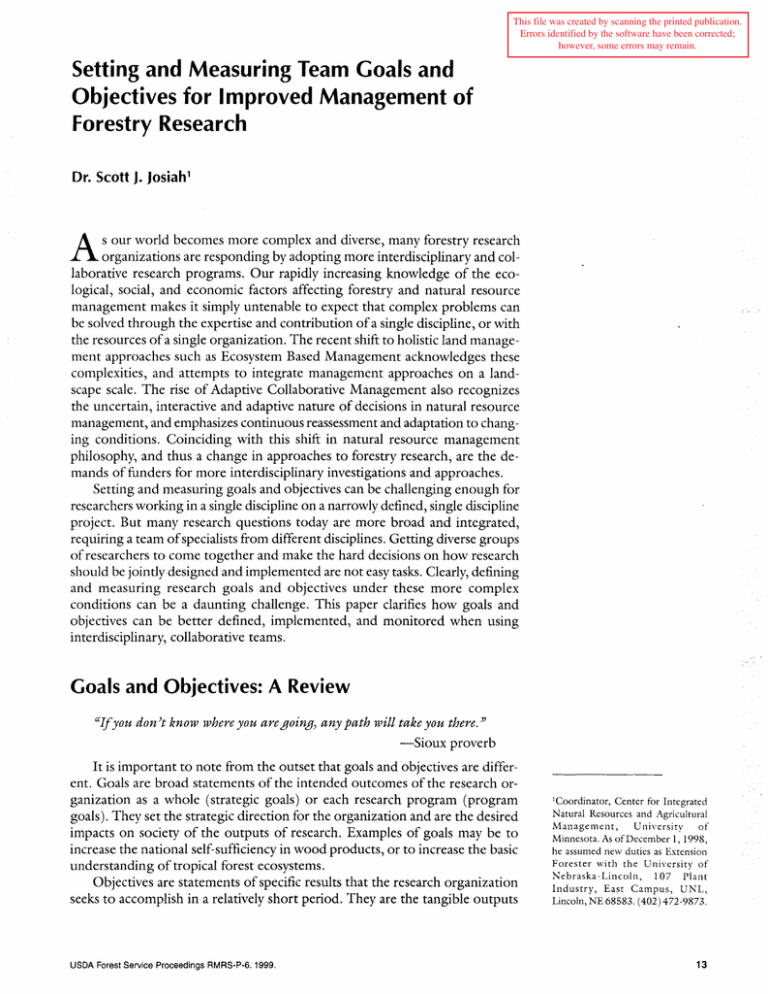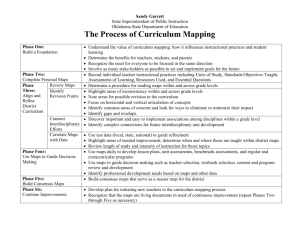Document 11871841
advertisement

This file was created by scanning the printed publication. Errors identified by the software have been corrected; however, some errors may remain. Setting and Measuring Team Goals and Objectives for Improved Management of Forestry Research Dr. Scott J. Josiah 1 A s our world becomes more complex and diverse, many forestry research organizations are responding by adopting more interdisciplinary and collaborative research programs. Our rapidly increasing knowledge of the ecological, social, and economic factors affecting forestry and natural resource management makes it simply untenable to expect that complex problems can be solved through the expertise and contribution of a single discipline, or with the resources of a single organization. The recent shift to holistic land management approaches such as Ecosystem Based Management acknowledges these complexities, and attempts to integrate management approaches on a landscape scale. The rise of Adaptive Collaborative Management also recognizes the uncertain, interactive and adaptive nature of decisions in natural resource management, and emphasizes continuous reassessment and adaptation to changing conditions. Coinciding with this shift in natural resource management philosophy, and thus a change in approaches to forestry research, are the demands of funders for more interdisciplinary investigations and approaches. Setting and measuring goals and objectives can be challenging enough for researchers working in a single discipline on a narrowly defined, single discipline project. But many research questions today are more broad and integrated, requiring a team of specialists from different disciplines. Getting diverse groups of researchers to come together and make the hard decisions on how research should be jointly designed and implemented are not easy tasks. Clearly, defining and measuring research goals and objectives under these more complex conditions can be a daunting challenge. This paper clarifies how goals and objectives can be better defined, implemented, and monitored when using interdisciplinary, collaborative teams. Goals and Objectives: A Review ccifyou don )t know where you are going, any path will take you there.)) -Sioux proverb It is important to note from the outset that goals and objectives are different. Goals are broad statements of the intended outcomes of the research organization as a whole (strategic goals) or each research program (program goals). They set the strategic direction for the organization and are the desired impacts on society of the outputs of research. Examples of goals may be to increase the national self-sufficiency in wood products, or to increase the basic understanding of tropical forest ecosystems. Objectives are statements of specific results that the research organization seeks to accomplish in a relatively short period. They are the tangible outputs USDA Forest Service Proceedings RMRS-P-6. 1999. 1 Coordinator, Center for Integrated Natural Resources and Agricultural Management, University of Minnesota. As of December 1, 1998, he assumed new duties as Extension Forester with the University of Nebraska- Lincoln, 107 Plant Industry, East Campus, UNL, Lincoln, NE 68583. (402) 472-9873. 13 Setting and Measuring Team Goals and Objectives Josiah of research. Objectives should be "SMART" - Specific, Measurable, Achievable, Results-oriented, and Timebound (Harrington-Macklin 1996). Examples of research objectives would be: • over the next 3 years, develop small-scale, affordable portable sawmilling technology appropriate to local conditions; or • develop, over 2 years, a high efficiency wood stove that reduces fuelwood consumption by 50%. Determining and clearly stating objectives is a powerful way to clarify the steps needed to reach goals. Objectives need not overly dictate or restrict a team's activities, a criticism often directed at the formal "Management by Objectives" approach. ((ObJectives are not fate; they are direction. They are not commands; they are commitments. They do not determine the future; they are means to mobilize the resources & energies of the business for the making of the future.)) -Peter Drucker, 1977 For effective interdisciplinary team-based research, the organization's strategic, program, and project goals and objectives must complement each other, with strong links between each level of planning. As Alvin Toffler wrote in 1988, "You've got to think of the 'big things' while you're doing the small things, so that all the small things go in the right direction." Goals and objectives must be dynamic--able to respond to changing conditions and priorities, achievable, and worth doing. Clearly, "if a research project is not worth doing at all, it is not worth doing well"(Lindermann, 1969). Who Sets and Prioritizes Goals and Objectives? On clear and effective goal setting: ccon a country hike, two city kids met a grizzly bear. One kid sat down to put on a pair of sneakers and made ready to run. The other kid said) scoffing) cPve read all there is to read aboutgrizzly bears) and no man can outrun a grizzly.) The first kid looked up and said) ci don )t care about outrunning the bear, I Just want to outrun youfY)) -Anonymous. Research organizations and teams use a number of approaches to setting and prioritizing goals and objectives. Goals and objectives can be solely determined by upper management (a top-down approach), although acceptance and support by research staff 1nay or may not be forthcoming. Or, they can be determined by the researchers themselves (a kind of li1nited botto1n-up approach, at least within the organization), with the risk that the research is not in line with the organization's strategic goals. A third option, with research questions being identified by the eventual users of the research, would be truly bottom-up in nature, but could result in ad-hoc research without an overall long-term focus. In practice, effective research organizations involve top management, scientists, and stakeholders in an iterative, collaborative process to set overall strategic goals, develop focused research programs, and identify specific research projects that meet stakeholders needs as well as fult111 the organizations strate- 14 USDA Forest Service Proceedings RMRS-P-6. 1999. Setting and Measuring Team Goals and Objectives Josiah gic goals. This top-down, bottom-up approach requires lots of communication and a commitment to the process. But the extra work is worth it, resulting in improved congruence between program and strategic goals, research that is better oriented toward real needs, and greater opportunities for potential users of the research results to provide input. Under such conditions, researcher "buy-in" is enhanced, and stakeholders feel ownership in the process and of the research results. Indeed, in an interdisciplinary, collaborative ponderosa pine research project, "a major reason for the smooth functioning of the team is that the scientists 'own' the concepts and participate voluntarily" (Oliver and Powers, 1998). It is not unusual for some members of a particular team to have been assigned to the effort by their organization. Under these circumstances, it is imperative that everyone involved has the authority to represent their organization in goal setting, and to ensure their achievement. Otherwise, the individual's effectiveness will be limited, hampering the entire team effort. A Framework for Successful Goal and Objective Setting Research teams with successful, effective goal and objective setting often exhibit the following eight characteristics: Accountability Team members must be accountable for their and the team's performance to their superiors and to their stakeholders. Responsibility They must be responsible for the day-to-day activities and resources being utilized by the project or effort. Authority They need to have the authority to delegate control of funds and resources to scientists and research staff, to determine and delegate activities that others may be doing, or to act themselves. In highly interdisciplinary and interorganizational research projects or programs, central coordination by a facilitator not strongly affiliated with any one discipline can be an effective way to manage the effort (Oliver and Powers, 1998). This assures that at least one member of the team has the authority to adhere to timetables, take care of reporting and administrative functions, foster communications, and keep the team on track. Indeed, a central coordinator can be an effective means to maintain team discipline and focus. As Benjamin Disraeli said nearly 130 years ago, "the secret of success is constancy to purpose," or in this case, goals and objectives. Communication Clear communications between members is clearly essential, given the breadth of disciplines and subsequent diversity of opinions on how things should be run. Teams need to spend considerable time early on to develop a commonly shared language and understanding of what is expected, an appreciation of the linkages between strategic, program and project goals, and consensus on USDA Forest Service Proceedings RMRS-P-6. 1999. 15 Setting and Measuring Team Goals and Objectives Josiah the team's goals and objectives. Frequent reiteration of the team's goals and objectives at meetings, in written communications, reports, and publications can help maintain and enduring consensus. This also provides multiple opportunities for the team to re-evaluate the relevance and "fit" of the current set of goals and objectives to current conditions. And, since there will always be conflicts among members on a diverse team, mechanisms for managing conflicts will need to be determined and agreed upon early on by the group. Participation and consensus building For teams to work effectively throughout their lifetime, a participatory approach right from the start can best build and maintain consensus and ensure research relevance. This allows for, and indeed should encourage, input from as broad a group of stakeholders as possible. In acquiring this input, a policy of inclusion rather than exclusion (even with project opponents) is desirable and worth the extra effort. It increases the chance that the project will have committed scientists willing to compromise to ensure project success, reduces "outof-the-blue," last minute objections from excluded stakeholders that could derail the effort, and is more likely to effectively integrate environmental, economic and social understanding and concerns. Access to resources Effective teams also need adequate and timely access to resources to perform the research. Delays and inadequate resources will quickly reduce team morale and effectiveness. Adequate incentives From either the individual or team perspective, adequate incentives are essential, as well as the elimination or reduction in the number of disincentives. For example, will a tenure-seeking academic team member receive adequate recognition from his or her employer for implementing a particular project when they are only one of many authors on the final papers? Indeed, according to Hersey and Blanchard ( 1972 ), "The productivity of a work group seems to depend on how the group members see their own goals in relation to the goals of the organization." Monitoring Effective monitoring systems are needed to establish performance milestones both for individual team members, and for the team as a whole. Effective monitoring systems for team-based research show a strategic dynamism, with built in mechanisms for feedback and adjustment. Such teams have frequent formal and informal team meetings to allocate funds, coordinate fieldwork and activities, and to assess performance in terms of outputs as well as impacts. Problems of Setting and Managing Team Goals and Objectives Teams that lack these eight characteristics typically exhibit a number of problems that ultimately result in increasingly unrealistic and/ or unrealized goals and objectives. Because of inadequate feedback loops, they may become static efforts that are unresponsive to stakeholder needs, leading to disgruntled 16 USDA Forest Service Proceedings RMRS-P-6. 1999. Setting and Measuring Team Goals and Objectives Josiah stakeholders and loss of support and funding. Organizations or teams will show greater stress, with growing interpersonal conflicts, and greater unpredictability and manageability. Some common problems interdisciplinary research teams tend to face inelude: • Confusion between goals and objectives, either because they have been incompletely developed and "processed" by the group, or are not clearly stated-meaning different things to different people, or are not measurable-resulting in poorly defined activities and inadequate feedback on performance. • Rushing the process, with incompletely developed or shared "comn1on" goals. Goal and objective setting with teams takes a lot of time and effort to come to consensus, particularly on teams with diverse members. Without making this early investment, subsequent performance will likely suffer significantly. • Excessive and unreasonable attention to the process of setting and achieving goals, to the point where the process becomes burdensome, bureaucratic, and hinders innovation. As Gardner wrote in 1964, " ... Little by little, preoccupation with method, technique, & procedure gains a subtle dominance over the whole process of goal seeking. How it is done becomes more important than whether it is done. Means triumph over ends. Form triumphs over spirit. Method is enthroned. Men become prisoners of their procedure, & organizations designed to achieve some goal become obstacles in the path to that goal." • Some team members may "free ride," not carrying their fair share of the work required. This may be a function of an individual's personality, the failure of their organization to provide them with the clear authority, responsibility or resources to act, or their lack of complete agreement with the group as to the goals and objectives of the effort and the ways to achieve them. • Poor or inequitable delegation of responsibility, authority, and distribution of resources, leading to delays, declining morale, and competition instead of collaboration among team members for resources. • Team members may occasionally find that their participation in the project conflicts with their other job responsibilities. A common question to their supervisor in such cases may be "Do you want me to do this, or my job?" • Rifts between team members from different backgrounds (e.g., scientists/farmers) that speak different languages (in a figurative sense) and with different personal reasons for participating can hamper team effectiveness. • Inadequate reward systems for interdisciplinary activities regarding promotion, recognition, etc., can become commonplace. Summary Setting and measuring individual and team goals and objectives is an essential part of the research management process. While they do not draw a distinction as this paper has between goals and objectives, Weinberg and Schulman USDA Forest Service Proceedings RMRS-P-6. 1999. 17 Setting and Measuring Team Goals and Objectives Josiah ( 1974) succinctly captured the nature and importance of goals and objectives to research management: ccNo experiment ... should be undertaken without clear, explicit & reasonable goals - unless the experiment is designed to measure the effect of unclear, implicit, or unreasonable goals.)) Well-defined goals and objectives help to guide the research management process and clarify its direction. They are essential to the success of collaborative, interdisciplinary approaches increasingly used in forestry research. Effective interdisciplinary, collaborative teams have members that are able to come to consensus on a project's goals and objectives, ensure they are congruent with those of their larger organization, and receive the management support, resources and incentives to effectively work together to achieve .these common a1ms. Literature Cited Disraeli, B. 1870. Speech given on June 4, 1870 (in: The Manager's Book of Quotations, Eigen, L.D. and Siegel, J.P., eds., American Management Association, New York, page 152). Drucker, P. 1977. People and Performance. Harper & Row, New York. Gardner, J. W. 1964. Self-renewal: the individual and the innovative society. Harper and Row, New York, p. 47. Harrington-Macklin, D. 1996. Keeping the team going: A tool kit to renew and refuel your workplace teams. American Management Assoc. New York. Hersey, P. and K. Blanchard. 1972. Management of Organizational Behavior. Prentice-Hall. Lindermann, H. 1969. Impact of science on society. United National Educational, Scientific, and Cultural Organization (UNESCO). (Cited inAP news release printed in the November 2, 1969, Sacramento Bee). Oliver and Powers. 1998. Interdisciplinary Field Research in Ponderosa Pine. J. ofForestry. Toffler, A. 1988. Newsweek, April4, 1988. Weinberg, G. and E. Schulman. 1974. Human Factors. 18 USDA Forest Service Proceedings RMRS-P-6. 1999.



